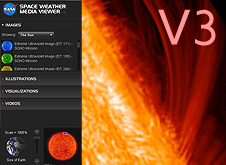National Aeronautics and Space Administration
Goddard Space Flight Center

Sun-Earth Day 2010: Magnetic Storms
What's Up?

Astronomer Lou Mayo
What's Up? Solar Minimal!
By Lou Mayo
The sun is asleep. Basically, that describes the activity level of our star, the sun, over the past year or so.
The sun goes through a prominent cycle of activity called the "Sunspot Cycle". Every 11 years or so, the number of sunspots on the sun peaks as do the number of solar storms. Half a cycle (around 5 1/2 years or so) later, the number of sunspots visible on the sun reaches a minimum. Most of the time, this cycle is fairly reliable. But there have been times where almost no sunspots were seen on the sun for decades at a time. The most famous of these is the "Maunder Minimum" named for solar astronomer Edward W. Maunder (1851-1928), which took place between 1645 and 1715. During this time, North America and Europe experienced a "mini ice age" with average annual temperatures 1/2 degree or so below expected or normal values. Even an apparently small drop in temperature like this, however, was enough to plunge much of the Northern hemisphere and perhaps the rest of the Earth into frigidly cold winters and unexpectedly mild summers. Evidence for 18 of these minima in solar activity over the last 1,000 years can be found in measurements of carbon 14, the radioactive decay product of Nitrogen 14, in tree rings which is related an increase in Galactic Cosmic Rays (GCRs) resulting from a corresponding decrease in solar activity during these times.
So, the sun has been unusually quite over the past year with very few sunspots. In fact only two of the last 14 sunspot cycles (cycles 12 and 15) which covers approximately 150 years of data, have had as many spotless days as we have now in cycle 24. So the question is being asked more and more: Could this be another Maunder Minimum? Could we be on the verge of another mini ice age? Could the recent panic surrounding global warming be replaced by concern over global cooling?
The sun-Earth system is very complex with many variables, dependencies, and cycles, so it is hard to say. Human impact on the growing abundance of greenhouse gasses seems certain but perhaps the jury is out regarding the overall impact to our planet. In the mean time, I'm going solar!
NASA Fact
The fastest coronal mass ejection was recorded on August 4, 1972 and traveled from the sun to earth in 14.6 hours - a speed of nearly 10 million kilometers per hour!


